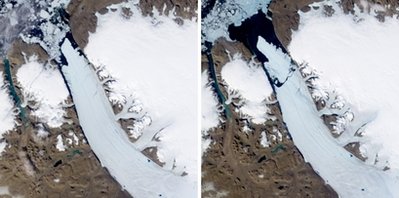Science and Health
Huge ice island could pose threat to oil, shipping
(Agencies)
Updated: 2010-08-11 14:36
 |
Large Medium Small |
|
|
STOCKHOLM - An island of ice more than four times the size of Manhattan is drifting across the Arctic Ocean after breaking off from a glacier in Greenland.
Potentially in the path of this unstoppable giant are oil platforms and shipping lanes - and any collision could do untold damage. In a worst case scenario, large chunks could reach the heavily trafficked waters where another Greenland iceberg sank the Titanic in 1912.
|
||||
"It's so big that you can't prevent it from drifting. You can't stop it," said Jon-Ove Methlie Hagen, a glaciologist at the University of Oslo.
Few images can capture the world's climate fears like a 100-square-mile (260-square-kilometer) chunk of ice breaking off Greenland's vast ice sheet, a reservoir of freshwater that if it collapsed would raise global sea levels by a devastating 20 feet (6 meters).
The world's newest ice island already is being used as a powerful emblem in the global warming debate, with US Rep. Edward Markey of Massachusetts suggesting it could serve as a home for climate change skeptics.
Researchers are in a scramble to plot the trajectory of the floating ice shelf, which is moving toward the Nares Strait separating Greenland's northwestern coast and Canada's Ellsemere Island.
If it makes it into the strait before the winter freeze - due to start next month - it would likely be carried south by ocean currents, hugging Canada's east coast until it enters waters busy with oil activities and shipping off Newfoundland.
"That's where it starts to become dangerous," said Mark Drinkwater, of the European Space Agency.
The Canadian Ice Service estimates the journey will take one to two years. It's likely to break up as it bumps into other icebergs and jagged islands. The fragments would be further ground down by winds and waves and would start to melt as they move into warmer waters.
"But the fragments may still be quite large," warned Trudy Wohlleben, a Canadian ice forecaster, who first spotted the massive chunk of ice on satellite images last Thursday.
The chunks of ice could be large enough to threaten Canada's offshore platforms in the Grand Banks off Newfoundland, said Wohlleben.
And, while it's possible to redirect smaller icebergs, by towing them or spraying them with water cannons, "I don't think they could do that with an iceberg this large," she said. "They would have to physically move the rig."



